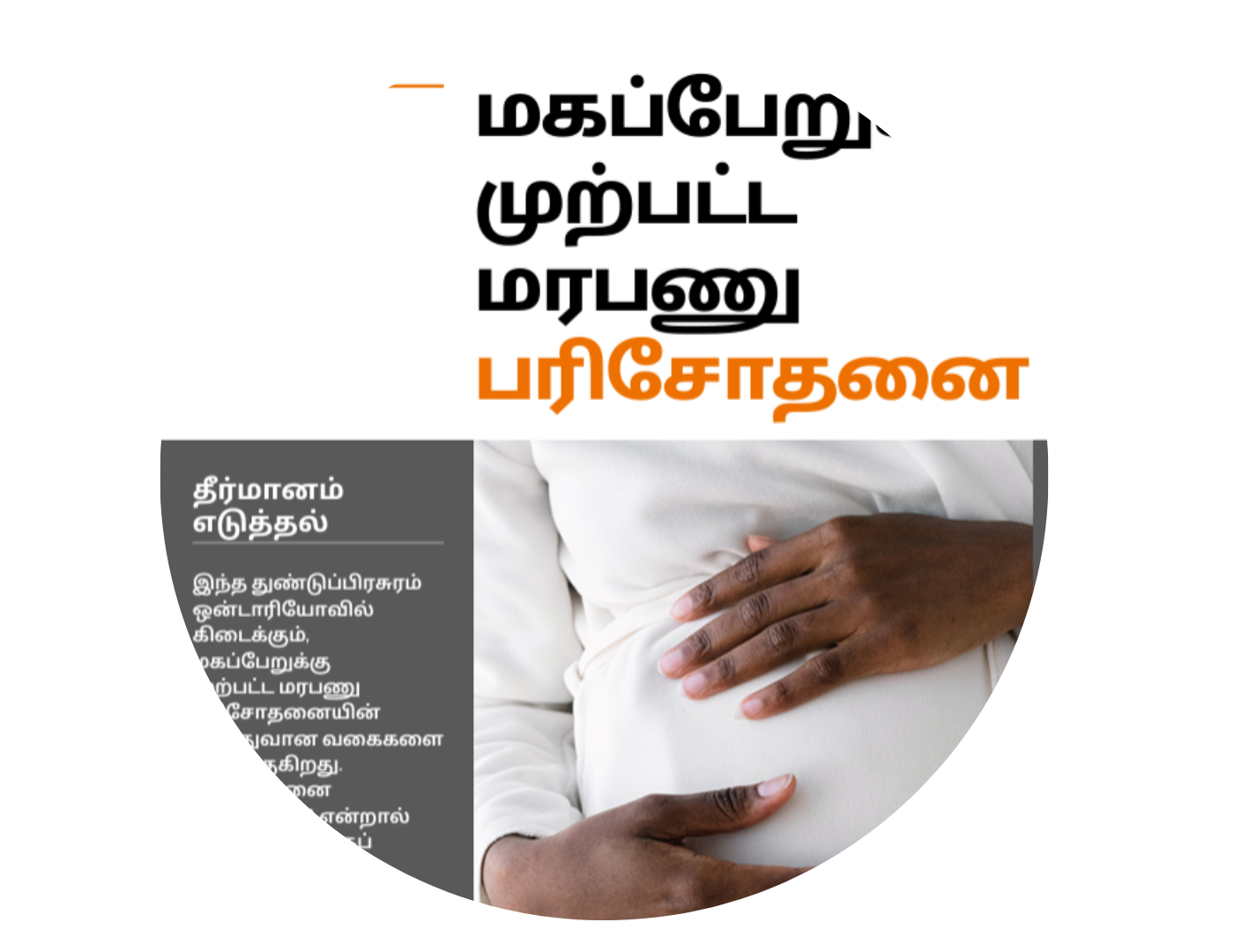Prenatal Screening Ontario (PSO) - Program Update, Winter 2025
| Included in this update: | |
|---|---|
|
1. Introduction 2. Did you know? 3. Prenatal Screening Landscape 4. Take a Closer Look... |
5. PSO Information Line 6. Nuchal Translucency Quality Assurance (NTQA) Program 7. Education and Outreach 8. Feedback |
Introduction
Prenatal Screening Ontario (PSO) is excited to share this update about screening for common aneuploidies with our partners, including but not limited to prenatal practitioners, sonographers, laboratories, and data contributors. In this report you will find fictional stories to illustrate and guide clinical practice, data and accessible resources for counselling pregnant women and individuals about the option of prenatal screening, its performance, results and next steps, statistics about the overall screening system, hear from a sonographer about their experience in the Nuchal Translucency Quality Assurance Program, and more. We hope that you find this information helpful and welcome your feedback and suggestions (pso@bornontario.ca). Please feel free to share this report widely with your colleagues. To note, updates regarding screening program expansion will be provided as available in 2025.
This report is interactive! Hover over figures and look for buttons like > or < to see more information.
The majority of data presented in this update are for records of singleton pregnancies with estimated due dates from April 1, 2020 to March 31, 2023; exceptions are noted for unique data holdings and where trends are illustrated. Please consider the timeline when comparing data from differing data holdings. BORN Ontario strives to better understand how our data can be used to inform health system partners on the intersection between social determinants of health, indigeneity, and perinatal and child health outcomes. This report includes data that may or may not support reflections on indigeneity and health equity. We cannot conclusively or accurately identify the extent to which BORN data reflect indigeneity and equity-deserving groups. This pursuit is ongoing, and we appreciate your support and ideas related to enabling our efforts in pursuit of more equitable outcomes and programming.
| Read more... |
|
In accordance with the Accessibility for Ontarians with Disabilities Act, accessible text is embedded within the graphics themselves or provided as text/table below the graphic in the "accessible text" accordion. Although significant effort has been made to ensure the accuracy of the information presented in this update, neither the authors nor BORN Ontario nor any other parties make any representation or warranties as to the accuracy, reliability or completeness of the information contained herein. Permission is granted for the reproduction of these materials solely for non‐commercial and educational purposes. Suggested citation: Prenatal Screening Ontario - Program Update, Fall 2024. Ottawa, Ontario, 2024. |
About PSO |
|
Prenatal Screening Ontario (PSO) is funded by the Government of Ontario to coordinate the operations of prenatal screening services in Ontario, supporting a cohesive and high-quality screening system. We are Ontario's resource for pregnant individuals, families and health-care professionals looking for information and updates related to prenatal screening. Interested in learning more about PSO? Check out our About Us information. |
About prenatal screening |
|
Acronyms |
|
Did you know?



An information pamphlet is available for pregnant individuals and their families in 15 languages:
English, French, Arabic, Chinese (Traditional and Simplified), Cree, Farsi, Italian, Inuktitut, Ojibway, Punjabi, Spanish, Tagalog, Tamil and Urdu.
The pamphlet gives an overview of the main prenatal genetic screening options, results and next steps.
Check out the pamphlets today!
OHIP-funded NIPT is available for all twin pregnancies. This can be ordered as a category I indicator by any physician or nurse practitioner. Check out the Non-Invasive Prenatal Testing (NIPT) Guide for complete ordering instructions.
Interested in why this change was made? Read the story, How is BORN Data Impacting our Knowledge of the Performance of Prenatal Genetic Testing in Ontario, in the 2021-2022 BORN Annual Report.
Are you a sonographer? Check out the Completing the Multiple Marker Screening Requisition Guide on our website.
Are you a practitioner? The PSO website has the most current version of the Multiple Marker Screening (MMS) and Non-invasive Prenatal Testing (NIPT) requisitions and helpful How To Order Guides featuring background information on why certain clinical information is needed for screening and step-by-step ordering instructions.
Prenatal screening landscape
Take a closer look at...
PSO Phone/Email Information Line
Did you know?
PSO has certified genetic counsellors available Monday-Friday, 9am-3pm, to answer prenatal screening questions from health-care practitioners, pregnant individuals and the general public. Contact us today! Toll-free 1-833-351-6490 or email: PSO@BORNOntario.ca.
- The most commonly asked category of questions was, "How to get/order Multiple Marker Screening." Check out the PSO Guides on Ordering MMS!
- To note, PSO does not have access to results nor the ability to process report amendments; ordering practitioners should contact the laboratory directly for these requests.
- General genetic counselling questions fall outside of PSO's scope, however, our genetic counsellors will provide resources to guide referral to the local Genetics or Maternal Fetal Medicine Clinic.
- Private-pay NIPT is outside the scope of PSO. Individuals with these questions are directed to contact the NIPT companies directly.
| Accessible text: | ||||||||||||||||||||||||||||||
|
Nuchal Translucency Quality Assurance (NTQA) Program
The Nuchal Translucency Quality Assurance (NTQA) program defines the requirements for NT registration in Ontario and provides the tools for supporting sonographers performing NT measurements for Multiple Marker Screening. Learn more about the NTQA Program on the PSO website.
Meet Sonographer, Katie Virgin, who shares their experience in PSO's Nuchal Translucency Quality Assurance Program.
Obstetrical Scanning: The Stakes are High and so are the Emotions
Imagine a job where you’re required to make precise measurements (to the tenth of a millimeter) and if they’re not accurate a pregnant person may be misinformed about their baby’s chance of having Down Syndrome. This is the reality for sonographers performing obstetrical scans – their work is meticulous, and the responsibility is immense.
One of the important measurements recorded by sonographers is nuchal translucency (NT) thickness. NT is a collection of fluid at the back of the fetal neck. Increased NT thickness can be associated with chromosomal differences, cardiac defects, and other genetic conditions. The NT measurement, along with bloodwork and demographic information, is used to calculate a patient’s chance of having a pregnancy affected with Down syndrome or trisomy 18.
Katie Virgin, an 11-year sonography veteran, acknowledges that her job is challenging: “Obstetrical scanning is one of the most difficult things we do because the stakes are high and so are the emotions. Accuracy is incredibly important for risk assessment.”
| Read more of Katie's story... |
|
Check Your Pride at the Door and Put Patients First So when Katie was approached by a team member from Prenatal Screening Ontario and told there were things she could do to improve her obstetrical scanning, she checked her pride at the door and embraced the opportunity to learn: “The moment a sonographer thinks ‘I don't have anything else to learn’ or ‘What's this person going to teach me?’, it’s time to hang up your probes, because that's a part of our careers. We’re always going to be learning”. Katie participated in the Quality Assurance Program offered by Prenatal Screening Ontario. The program provided Katie the opportunity to refine her NT measurements through an imaging review protocol. The team at Prenatal Screening Ontario collects NT measurement data in the BORN Information System and correlates it with sonographer ID numbers to create personalized performance reports. This is a critical piece of the quality assurance program - sonographers can log into the BORN Information system and compare their data with internationally accepted standards. Looking at their own NT performance report helps sonographers understand biases and habits in their ultrasound practice. Prenatal Screening Ontario also provides a variety of educational resources and point-of-care tools to support sonographers in their practice. Katie says the fields of radiology and sonography are incredibly humbling and involve constant learning and evolving: “You have to guard against complacency”. But the rewards are worth it: “It’s a great feeling when I know I’ve captured all the things I need to in one tiny picture - that I've gotten the best data for a patient, which is what they deserve. That's why they're here”. |
Education and outreach
Provider tools
Printable point-of-care tools are available on the PSO website and serve as useful guides for pregnant individuals and practitioners.
Private in-services
Our genetic counsellors and NT clinical content specialist are available for educational sessions and can tailor the content and platform to the specific needs of various health care practitioner groups. Please contact pso@bornontario.ca to set up an educational session for your workplace!
Feedback
Let us know what you think of this report. Please contact us directly at PSO@bornontario.ca with feedback.








 Subscribe to this page
Subscribe to this page